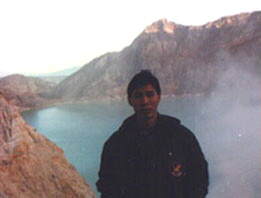

The Ijen Plateau lies in the centre of the Ijen-Merapi-Maelang Reserve, which extends over much of the mountainous region directly west of Banyuwangi and borders on the Baluran National Park in the north east. As at Bromo, the caldera is best viewed from the air. Almost all commercial flights operating between Denpasar - Surabaya, Yogyakarta or Jakarta usually fly, if not directly over, then close by Ijen plateau, where the seemingly luminous blue/green crater lake forms an unmistakeable landmark.
The main attraction at Ijen is the large, sulphureous crater lake which lies hidden between sheer walls of deeply furrowed rock at more than 200 metres. The Ijen crater itself lies at approximately 2,300 metres above sea level. It forms a twin volcano with the now extinct Mount Merapi. The enormous crater lake, which is 200 metres deep and covers an area of more than half a million square metres, contains about 36 million cubic metres of steaming, acid water. A walk around the lake will take a full day trip.
Ijen crater shows a special type of volcanic feature common to Indonesia, about 1 kilometre in diametre and 175 metres deep. The floor is covered completely by a warm lake, milky blue green in colour, held back by a dam built many years ago by the Dutch, in order to keep the hot, mineral laden water from raining the crop lands below.
The temperature drops at night, near the crater rim it can fall to about 5 degree Celcius. The road ends at Jampit, where very basic shelter is available. It is also possible to sleep in the old vulcanology station further up the hill, now used by sulphur collectors, but permission must be obtained in advance.
The sulphur is transported entirely on foot. In the past, horses were used but they were found to be less practical on the hazardous terrain. Today, the mine yields nine to twelve tons of sulphur per day. Individual loads of up to 70 kg are carried by men, often barefooted, up to the rim of crater and then 17 km down the mountainside to a factory near Banyuwangi. The porters are paid by weight.
The most important advice if you are travelling to Ijen is : "If you lose your way, just look out for the sulphur trail". The meaning was clear, since a continuous flow of two way traffic, carrying the sulphur down the mountainside from the lake and trudging up again to re-load, had left a yellow trail on the well worn path.
The crater can be reached from either the east or the west. The latter
is more popular approach, since the climb from the road's end to the edge
of the lake takes shorter time.